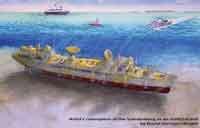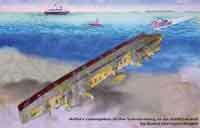Dear Mr. Weatherby,
Stevens Institute of Technology is extremely pleased to participate in the Wreck Vandenberg project. We are excited by the research and education potential of this unique effort. By virtue of its size and location, the Wreck Vandenberg offers a unique opportunity to conduct leading-edge ocean engineering and coral reef ecological studies. The project also represents a significant opportunity to educate students across an array of scientific and engineering disciplines, and inform the general public about issues related to coral reef habitat restoration and preservation.
As currently envisioned, our participation will include the following efforts
A research project aimed at identifying the viability of using chemical cues imbedded in an engineered calcium carbonate structure to enhance the recruitment and settlement of coral larvae. This project will be conducted at several locations along the decks of the Vandenberg, using various “control” (untreated) substrate as well as the engineered substrate in order to enable the assessment of the success of the proposed design. If successful, this design would significantly enhance efforts to repair coral reef habitat destroyed, e.g., by ship groundings.
A long-term monitoring project to examine the material behavior of the wreck, that is, the rate of decay – if any – of the hull. By conducting field measurements of hull thickness over time and at various locations along the hull, we will characterize the long-term behavior of the structure, and identify the factors contributing to any perceived variability in rate of decay – e.g., proximity to water surface, presence of marine growth/coral.
Long term monitoring of the stability of the wreck, that is, the response of the vessel to extreme storm events.
An exciting new educational venture that seeks to educate and inform US students and the general public by following the wreck project from beginning to end, including the cleaning process, the towing of the vessel from Virginia to Key West, the actual sinking, and the structural and biological transformation of the wreck over the ensuing years. Each of these aspects of the project will form an educational “module” that can be used by science teachers from grade school through university, and by ocean engineering and naval architecture educators. We anticipate that Stevens will work with the Florida Keys Community College in developing project-based curricula for use in oceanography, marine biology, ocean engineering, and naval architecture courses. Stevens has been a pioneer in the use of project-based learning to enhance the undergraduate experience in science and engineering. Stevens has also pioneered the use of the Internet in the development and delivery of project-based learning modules for use by grade school and high school teachers. Stevens’ Center for Improved Engineering and Science Education (CIESE) was established in 1988 has worked with school systems around the country to assist teachers in using computer technology to enhance instruction and student achievement. As wireless bandwidth continues to grow, another exciting use of the wreck as an educational platform is evolving – the use of the Wreck Vandenberg as an “underwater classroom”, with lectures conducted in real-time over the Internet on topics ranging from marine biology and ecology to ocean currents, wave dynamics and underwater structure behavior.
We look forward to an exciting and productive partnership with Artificial Reefs of the Keys!
Sincerely
Michael S. Bruno PhD, PE
Professor and Director
Davidson Laboratory
Stevens Institute of Technology
Hoboken , NJ 07030
|

|
 |

|
Like This
|
Not This
|
|
For the maximum success of the artificial reef as a habitat, diving site, and research platform, it is very important that the position and orientation of the ship be controlled. To ensure this positioning, as well as safety during towing and scuttling, engineering simulations are planned to test performance in various conditions. The Davidson Marine Hydrodynamics Laboratory at Stevens Institute in Hoboken NJ has undertaken the project to conduct these tests.
Click here for a PowerPoint presentation about the Lab.
|
| |
|
A letter from the director of the Davidson Lab
|
| Plans for testing |
Intentional Sinking of USAFS Gen. Hoyt S. Vandenberg to Serve as an Artificial Reef
An Experimental Study using 1/70th-Scale Model
A proposal/white-paper
PI: Michael S Bruno, , 201-216-5338
Co-PI: Raju Datla, , 201-216-5568
It has been proposed to bring the decommissioned ship USAFS Gen. Hoyt S. Vandenberg to the Florida Keys and sink it in waters 140 ft deep to serve as an artificial reef. At 520 ft long and 100 ft deep (keel to top of antennas), this will be the largest ship ever intentionally sunk for this purpose and will become a world-class diving destination. The vessel will become a habitat and breeding site for countless marine species and offer many other benefits to the environment and to education and research.
Since the ship characteristics will have changed significantly after it is prepared for this purpose, there will be significant challenges involved with respect to stability and seakeeping during the towing and sinking operations. We would like to study these issues under various possible scenarios in some detail using a scaled model and propose to perform these following tasks:
A 1/70th scale model of the ship including the superstructure will be constructed. The model will have pluggable openings of the 7 ft x 10 ft rectangular access holes and another set of small holes at various locations to allow water entry during the “sinking” studies.
Calm-water Resistance Tests on the bare hull at different drafts will be conducted in the Davidson Laboratory High Speed Test Basin . Instrumentation will be installed for the measurement of resistance, trim angle, and heave motion.
Seakeeping tests will be made at different drafts and access hole opening configurations. Measurements will be made of Drag, Heave and Pitch and statistical analysis will be performed to obtain significant values (1/3rd highest, 1/10th highest and extreme values) of the motions. Incidences of water entry through the openings will be observed.
The sinking studies will be performed in the laboratory square basin with the water depth reduced to 2 ft (representative of 140 ft full-scale depth). Tests will be made under different scenarios that include variations in number, size, location and timing of hole openings for water entry. The sinking will be recorded using both surface and underwater video cameras. |
|

|
|
|










 

|
| Link to Stevens Institute |
Link to Davidson Laboratory |
| Link to Ocean Engineering Dept. |
RTP Live: Data Real-Time yang Membantu Pemain
Slot dengan minimal depo 5k sangat cocok bagi pemain yang ingin bermain dengan cermat dan mengelola keuangan mereka dengan baik. Dengan deposit yang terjangkau, pemain dapat menikmati berbagai permainan slot tanpa mengeluarkan banyak uang. Kunci untuk sukses adalah memilih Slot Depo 5k dengan RTP tinggi dan melakukan taruhan secara bijak, sehingga pemain dapat memaksimalkan peluang kemenangan.
RTP live merupakan salah satu perkembangan paling menarik dalam industri perjudian online. Dengan menyediakan data real-time tentang tingkat pengembalian dari permainan RTP Live, RTP live memungkinkan pemain untuk melihat dengan jelas bagaimana mesin slot beroperasi pada saat itu. Ini tidak hanya meningkatkan transparansi, tetapi juga memberikan pemain kesempatan untuk membuat keputusan yang lebih tepat. Misalnya, jika Anda melihat bahwa sebuah slot memiliki RTP yang tinggi pada saat tertentu, Anda mungkin ingin melanjutkan permainan tersebut. Dengan informasi yang selalu diperbarui, pemain dapat menyesuaikan strategi mereka berdasarkan kinerja mesin saat ini, memberikan keunggulan yang signifikan dalam permainan. Dalam industri yang dipenuhi dengan elemen acak, data real-time ini memberikan informasi berharga yang bisa digunakan untuk meraih kemenangan. Oleh karena itu, pemain harus memanfaatkan RTP live untuk memaksimalkan peluang mereka dalam permainan.
Keunikan Slot Mahjong terletak pada kombinasi tema tradisional dengan teknologi modern. Dengan fitur interaktif dan hadiah besar, slot ini menjadi favorit bagi banyak pemain di seluruh dunia. Jangan lewatkan keseruan memutar gulungan di Slot Mahjong.
Slot Gacor Online Menawarkan Berbagai Keuntungan dan Peluang Menang Lebih Besar untuk Pemain
Slot gacor online menawarkan berbagai keuntungan bagi pemain, terutama dalam hal peluang menang. Permainan dengan RTP tinggi memberikan pemain kesempatan lebih besar untuk meraih kemenangan. Selain itu, Slot Gacor online juga menawarkan berbagai fitur bonus yang meningkatkan peluang pemain untuk meraih jackpot.
Salah satu alasan mengapa banyak orang tertarik bermain slot online adalah karena kesederhanaannya. Slot Toto menjadi pilihan favorit karena menawarkan pengalaman bermain yang seru dengan fitur-fitur unggulan. Selain peluang jackpot besar, permainan ini juga sering memberikan bonus dan free spins yang bisa dimanfaatkan oleh pemain. Keamanan dan kenyamanan juga menjadi prioritas utama dalam permainan ini, sehingga pemain dapat bermain dengan tenang tanpa khawatir mengenai transaksi maupun privasi mereka.
Dengan berbagai macam fitur menarik, Slot 777 mampu memikat banyak pemain. Permainan ini menawarkan peluang untuk memenangkan hadiah besar dengan cara yang menyenangkan. Jika Anda mencari permainan slot yang menawarkan sensasi tinggi, Slot 777 adalah pilihan yang tepat untuk dimainkan.
Selami Sensasi Toto Togel di Situs Togel Terpercaya yang Menawarkan Pengalaman Bermain Super Mulus
Untuk mendapatkan pengalaman bermain togel yang terbaik, memilih Situs Togel yang terpercaya adalah langkah pertama yang sangat penting. Dengan banyaknya situs togel yang tersedia, pemilihan yang cermat sangat diperlukan untuk menghindari risiko penipuan atau masalah lainnya. Situs togel yang memiliki reputasi baik biasanya menawarkan keamanan transaksi yang terjamin, serta menawarkan berbagai pasaran togel seperti Singapura, Hongkong, dan Macau. Pemain juga bisa memanfaatkan berbagai bonus dan promo yang tersedia untuk meningkatkan peluang kemenangan mereka.
Dalam permainan togel, keberuntungan memang berperan penting, tetapi strategi berbasis Data Macau juga tidak boleh diabaikan. Banyak pemain sukses yang tidak hanya mengandalkan insting, tetapi juga menggunakan data historis untuk menyusun angka taruhan mereka. Dengan mengamati pola yang terdapat dalam Data Macau, mereka dapat membuat prediksi yang lebih akurat dan meningkatkan peluang kemenangan. Oleh sebab itu, semakin lengkap dan terpercaya sumber data yang digunakan, semakin besar pula kesempatan pemain untuk mendapatkan hasil yang lebih baik di setiap putaran taruhan.
Keluaran Macau Akurat Membantu Pemain Tentukan Kombinasi Angka
Update harian Keluaran macau menjadi kunci bagi pemain togel untuk meninjau angka sebelumnya, menilai performa taruhan, dan menyiapkan kombinasi angka yang paling menjanjikan agar peluang meraih kemenangan meningkat.
Strategi Menang Besar di Slot Depo 10k untuk Pemain Pemula dan Berpengalaman
Teknologi pembayaran instan seperti Slot Qris membuat proses top up semakin praktis tanpa harus menunggu lama.
Banyak pemain internasional kini melirik slot Thailand sebagai pilihan utama mereka karena selain menawarkan gameplay menyenangkan, mesin ini juga memiliki potensi jackpot besar dan fitur modern yang membuat sesi bermain semakin seru.
Sbobet88: Situs Resmi dengan Sistem Taruhan Transparan
Popularitas Sbobet88 tidak hanya datang dari permainan olahraganya yang lengkap, tetapi juga dari reputasi globalnya sebagai penyedia layanan taruhan dengan lisensi resmi dan sistem yang selalu diaudit untuk menjamin transparansi serta keadilan bagi seluruh pemain.
Related Links
Partner Links



